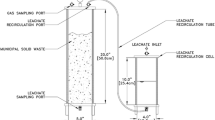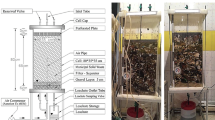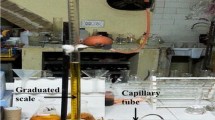Abstract
Unscientific disposal of municipal solid waste (MSW) brings a remarkable change in MSWs physical, geotechnical, and biochemical properties, which is responsible for landfill design failures, leading to environmental pollution. Therefore, bioreactor landfill is one of the recent technologies used in India nowadays. Although the physical, engineering, and biochemical properties of MSW have extensively been studied, only a few researchers were reported to work on the behaviour and composition of MSW with degradation levels in a large bioreactor simulator. However, the behaviour of MSW is unpredictable with biodegradation due to its heterogeneous nature. The bioreactor landfills studies have yet to be explored in India. There is a need to examine this subject to continuously monitor bioreactor simulators during the long-term degradation of MSW. MSWs physical, geotechnical, and biochemical properties for landfill design undergoing biodegradation were investigated using specially designed large- and small-scale bioreactor simulators. Laboratory tests were conducted on fresh MSW collected from Solid Waste Management Plant Vilholi Nasik (MH), India. Hydraulic conductivity ranged between 9.70 × 10–2 and 4.36 × 10–4 cm/s. A direct shear test was conducted on MSW for different stages of degradation and found that the angle of shearing resistance decreases in a narrow range from 19° to 16° with the increase in degree of decomposition (DOD). At the same time, cohesion increases from 10 to 31 kPa as DOD increases. A strain of up to 1.2% was found in the MSW sample. This study also reports the laboratory measurement of pH, alkalinity, chemical oxygen demand (COD), and biogas. The biogas concentration for CO2 has been reduced from 89 to 17%, while CH4 concentration was increased from 10 to 63%. The modified Gompertz model was developed for cumulative biogas production.













Similar content being viewed by others
References
Reddy KR, Hettiarachchi H, Giri RK (2015) Effects of degradation on geotechnical properties of municipal solid waste from Orchard Hills Landfill, USA. Int J Geosynth Gr Eng Springer Int Publ 1(24):1–14. https://doi.org/10.1007/s40891-015-0026-2
Huang Y, Fan G (2016) Engineering geological analysis of municipal solid waste landfill stability. Nat Hazards 84:93–107. https://doi.org/10.1007/s11069-016-2408-8
Blight GE (2008) Slope failures in municipal solid waste dumps and landfills: a review. Waste Manage Res J Sustain Circ Econ SAGE 26(5):448–463
Seed RB, Mitchell JK, Seed HB (1990) Kettleman Hills waste landfill slope failure II: stability analyses. J Geotech Eng 116(4):669–690. https://doi.org/10.1061/(ASCE)0733-9410(1990)116:4(669)
Blight GE (2004). A flow failure in municipal solid waste landfill-the failure at bulbul South Africa. In: Advances in geotechnical engineering, the Skempton conference Thomas Telford London pp. 777–788
Eid BHT, Stark T, Evans WD, Sherry PE (2000) Municipal solid waste slope failure. I: waste and foundation Soil properties. Geotech Geoenviron Eng 126:397–407. https://doi.org/10.1061/(ASCE)1090-0241(2000)126:5(408)
Lakshmikanthan P, Babu GLS (2017) Performance evaluation of the bioreactor landfill in treatment and stabilization of mechanically biologically treated municipal solid waste. Waste Manag Res 35(3):285–293. https://doi.org/10.1177/0734242X16681461
Pulat FH, Yukselen-Aksoy Y (2013) Compaction behavior of synthetic and natural MSW samples in different compositions. Waste Manag Res. https://doi.org/10.1177/0734242X13507967
Fei X, Zekkos D, Raskin L (2014) An experimental setup for simultaneous physical, geotechnical, and biochemical characterization of municipal solid waste undergoing biodegradation in the laboratory. Geotech Test J 37(1):1–14
Barlaz MA, Ham RK, Schaefer DM (1990) Methane production from municipal refuse: a review of enhancement techniques and microbial dynamics. Crit Rev Environ Sci Technol 19(6):557–584. https://doi.org/10.1080/10643389009388384
Šan I, Onay TT (2001) Impact of various leachate recirculation regimes on municipal solid waste degradation. J Hazard Mater 87(1):259–271. https://doi.org/10.1016/S0304-3894(01)00290-4
Hao YJ, Wu WX, Wu SW, Sun H, Chen YX (2008) Municipal solid waste decomposition under the oversaturated condition in comparison with leachate recirculation. Process Biochem 43(1):108–111. https://doi.org/10.1016/j.procbio.2007.10.004
Ahire V, Behera DK, Saxena MR et al (2022) Potential landfill site suitability study for environmental sustainability using GIS-based multi-criteria techniques for Nashik and environs. Environ Earth Sci 81:178. https://doi.org/10.1007/s12665-022-10295-y
Endait M, Patil S (2020) Laboratory investigation of compaction characteristics of fresh and degraded municipal solid waste. Waste Dispos Sustain Energy 2:305–312. https://doi.org/10.1007/s42768-020-00049-6
American Public Health Association (APHA) (2005) Standard methods for the examination of water and wastewater. 22nd edn. Washington, DC, USA
IS 2720-13 (1986): Methods of test for soils, Part 13: Direct shear test. Bureau of Indian Standards, New Delhi
Reddy KR, Hettiarachchi H, Gangathulasi J, Bogner JE (2011) Geotechnical properties of municipal solid waste at different phases of biodegradation waste management. Waste Manage Elsevier Ltd 31(11):2275–2286. https://doi.org/10.1016/j.wasman.2011.06.002
Gomes C, Lopes ML, Lopes MG (2005) A study of MSW properties of Portuguese landfill. In: Proceedings of international workshop on hydro-physico mechanics of landfills LIR-IGM, France
Gabr MA, Valero SN (1995) Geotechnical properties of municipal solid waste ASTM. Geotech Test J 18(2):241–251
Mali ST, Khare KC, Biradar AH (2012) Enhancement of methane production and bio-stabilization of municipal solid waste in anaerobic bioreactor landfill. Biores Technol 1(10):10–17. https://doi.org/10.1016/j.biortech.2011.12.027
Hossain MS, Penmethsa KK, Hoyos L (2009) Permeability of solid waste in bioreactor landfill with degradation Geotech. Geol Eng 27(1):43–51. https://doi.org/10.1007/s10706-008-9210-7
Beaven RP, Powrie W, & Zardava K (2008) Hydraulic properties of MSW. In: proceedings geotechnical characterization, field measurement, and laboratory testing of municipal solid waste. Presented at the international symposium on Waste Mechanics pp 1–43. Reston, VA: ASCE
Durmusoglu E, Corapcioglu YM, Tuncay K (2006) Modelling of settlement in saturated and unsaturated municipal landfills. Int J Geomech 6(4):269–278. https://doi.org/10.1061/(ASCE)1532-3641(2006)6:4(269)
Bareither CA, Benson CH, Edil TB (2012) Effects of waste composition and decomposition on the shear strength of municipal solid waste. J Geotech Geoenviron Eng 138(10):1161–1174. https://doi.org/10.1061/(ASCE)GT.1943-5606.0000702
Hossain MD, Sahadat H, Mohamed A (2009) The effects of daily cover soils on shear strength of municipal solid waste in bioreactor landfills. Waste Manage 29(5):1568–1576. https://doi.org/10.1016/j.wasman.2008.12.017
Gabr MA, Hossain MS, Barlaz MA (2007) Shear strength parameters of municipal solid waste with leachate recirculation. J Geotech Geoenviron Eng 133(4):478–484
Singh MK, Sharma JS, Fleming IR (2009) Shear strength testing of intact and recompacted samples of municipal solid waste. Can Geotech J 46(10):1133–1145
Reddy KR, Hettiarachchi H, Gangathulasi J, Bogner JE, Lagier T (2009) Geotechnical properties of synthetic municipal solid waste. Int J Geotech Eng 3(3):429–438. https://doi.org/10.3328/ijge.2009.03.03.429-438
Funding
The authors declare that no funds, grants, or other support were received.
Author information
Authors and Affiliations
Corresponding author
Ethics declarations
Conflict of interest
The authors declare no conflict of interest pertaining to the manuscript submitted.
Ethical approval
This research does not involve any animal studies or human participants.
Informed consent
For this type of study, formal consent is not required.
Rights and permissions
Springer Nature or its licensor (e.g. a society or other partner) holds exclusive rights to this article under a publishing agreement with the author(s) or other rightsholder(s); author self-archiving of the accepted manuscript version of this article is solely governed by the terms of such publishing agreement and applicable law.
About this article
Cite this article
Patil, S., Endait, M. Experimental investigation of biochemical and geotechnical properties of municipal solid waste undergoing biodegradation for landfill design. Innov. Infrastruct. Solut. 8, 291 (2023). https://doi.org/10.1007/s41062-023-01263-x
Received:
Accepted:
Published:
DOI: https://doi.org/10.1007/s41062-023-01263-x




